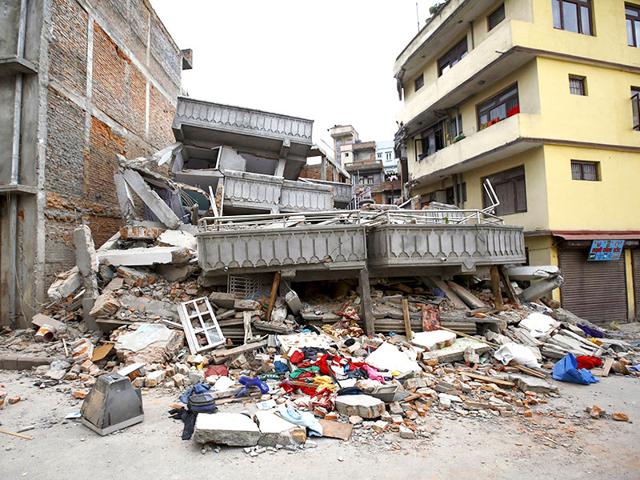Earthquakes don't kill, poorly constructed buildings do
Last Saturday, I was at home watching a movie when my 20-floor apartment building began swaying wildly. Okay, wildly is an exaggeration, but believe me at that point I really felt so. “Earthquake, move down”, a neighbour sent a BBM message.
Last Saturday, I was at home watching a movie when my 20-floor apartment building began swaying wildly. Okay, wildly is an exaggeration, but believe me at that point I really felt so. “Earthquake, move down”, a neighbour sent a BBM message.

But rushing down from the 15th floor is neither easy nor the best option – and so I decided to stay put. The aftershock came a few minutes later, and my resolve to stay back took a beating. I ran downstairs.
By the time I got back to my flat, news and visuals from Nepal confirmed that it was more than a shake, it was like a mega-temblor.
Since that day, warnings have been coming thick and fast for residents of the National Capital Region (NCR), which encompasses the National Capital Territory of Delhi and urban areas surrounding it in Haryana, Uttar Pradesh and Rajasthan.
Experts say that about half the NCR sits atop Seismic Zone IV, making it vulnerable to earthquakes that can go up to 8-magnitude or as devastating as the one that hit Nepal. The region would have been flattened if the epicentre of the quake had been in or near Delhi.
The devastation in NCR would have been huge because of two reasons: First, high seismicity and second, unplanned growth that compromises on structural safety standards of buildings.
Newly constructed houses rarely abide by the National Building Code 2005, Master Plan of Delhi 2021, Vulnerability Atlas 2006, and building bylaws.
Cut the jargon and this is what it means: Builders (especially the medium and small ones) and civic authorities are taking NCR citizens for a ride by constructing and approving buildings that are not earthquake resistant. Civic authorities too are not undertaking monitoring of the buildings.
Fragile development
Rapid urbanisation, rising demand for homes, shrinking availability of land and an increase in the Floor Area Ratio are inducing developers to go for high rises in the NCR.
“Earthquakes don’t kill, buildings do. Unfortunately, many small and medium developers are cutting costs and so are not investing enough to make their buildings earthquake proof even though it is legally binding on them,” explained Avikal Somvanshi, senior research associate for the Sustainable Buildings and Habitat Programme at the Centre for Science and Environment (CSE), New Delhi.
A survey by the National Disaster Management Authority found that in the past 25 years, more than 25,000 human fatalities were caused by collapse of buildings during earthquakes.
“The condition and quality of Indian building stock is poor when it comes to seismic performance, the performances of reinforced concrete buildings are unsatisfactory,” added Somvanshi.
During the 2001 Bhuj earthquake, reinforced concrete buildings collapsed during temblor of just 6-magnitude, when a well-designed reinforced concrete building is expected to collapse only when it is 7.5-magnitude or higher.
The damage caused to these buildings was high compared to any other country for similar level of ground-shaking. So it’s a no-brainer that the housing risk in India should be minimised to reduce loss of life and property in future earthquakes.
Weak enforcement
Today, India has a good range of seismic codes covering a variety of structures, ranging from mud or low strength masonry houses to modern buildings. However, the key to ensuring earthquake safety lies in having a robust mechanism that enforces and implements these design code provisions in constructions.
“The problem becomes more pronounced in the NCR because here the governance structures (municipalities) are weak and the implementation of seismic rules is tardy. This is further complicated as municipalities also don't have enough structural engineers who specialise in seismology to undertake monitoring,” said Somvanshi.
Retrofitting
While new building codes can apply to new buildings, there is a need to retrofit existing buildings to make them safer. There are around 25 lakh such buildings in Delhi alone. However, while the know-how for retrofitting is in place, neither a survey nor an effort to initiate this massive project has begun.
CSE researchers pointed out that the Tejendra Khanna Committee, set up in 2006 to look into various aspects of unauthorised constructions and misuse of premises in Delhi, found that 70% to 80% structures had violated the Building and Development Control Regulations.
In April 2011, the Delhi government made it mandatory for all builders to submit sanctioned building plans with structural safety certificates for their new buildings. Within days, the number of applicants for property registration saw a drastic fall.
Ten days later, the MCD informed the government that it did not have enough engineers to issue the certificates. The order was revoked.
Approvals
When it comes to approvals, research has shown that most builders get only the ground floor approved. “Four to five floors are added once the completion and occupancy certificates for the ground floor are obtained,” said a contractor during a research study conducted by CSE.
“Adhering to planning norms, by-laws and safety standards wastes valuable floor space. Financial stakes are too high in these small- and medium-scale projects to allow such wastage of saleable floor area,” the contractor admitted blatantly.
However, a part of the responsibility lies with property buyers. How many of us bother to find out whether their buildings are earthquake resistant? Most buyers are more worried about the design of the building, not the quality of the structure.
The NDA government is betting big time on smart cities. While building them, it must ensure that these are resilient cities that are low risk to natural and man-made disasters.
And what happens to the existing cities that are bursting at the seams? Why isn’t anyone talking of making them at least resilient, if not smart, cities?
(The views expressed by the writer are personal. She tweets as @kumkumdasgupta.)





